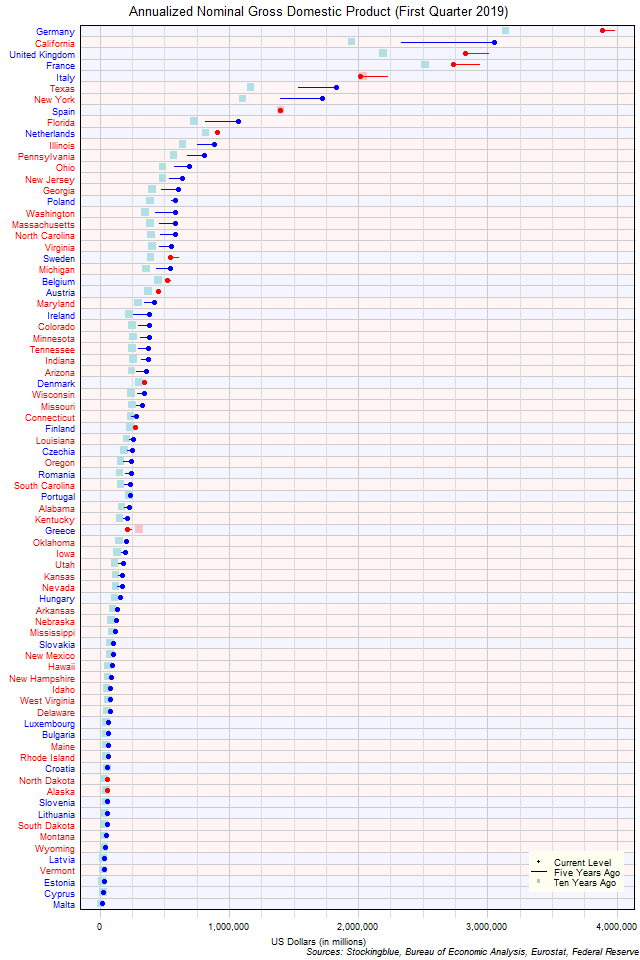
The chart above shows the annualized nominal gross domestic product (GDP) in each EU and US state as of the first quarter of 2019 in millions of US dollars, the change from five years ago, and the GDP ten years prior. Germany continues to be the largest economy but California is hot on its tail.
Findings
- The difference between the state with the largest GDP, Germany, and the state with the smallest, Malta, is $3,871,299.55 million (down from $3,967,898.67 million five years ago and up from $3,132,310.48 million ten years ago). Germany and Malta had the largest and smallest GDP respectively both five and ten years ago.
- Germany has 266.49 times the GDP that Malta does. The ratio of largest GDP to smallest GDP was down from 354.57 five years ago and down from 402.42 ten years ago.
- The median GDP in the 28 EU states is $244,200 million (up from $239,601 million five years ago and up from $225,935 ten years ago) and the mean $659,943 million (down from $679,344 five years ago and up from $566,586 ten years ago).
- The median GDP in the 50 US states is $241,469 million (up from $190,090 million five years ago and up from $165,387 ten years ago) and the mean $416,138 million (up from $337,423 five years ago and up from $283,982 ten years ago).
- The median GDP in the 78 EU and US states is $244,036.51 million (up from $220,305.99 million five years ago and up from $197,380.34 ten years ago) and the mean $503,657.61 million (up from $460,163.85 five years ago and up from $385,429.54 ten years ago).
- Sixty-four states saw their GDP rise in current dollars from five years ago (48 from the US and 16 from the EU) while 14 states saw their GDP drop in current dollars (two from the US and 12 from the EU).
- Seventy-five states saw their GDP rise in current dollars from ten years ago (50 from the US and 25 from the EU) while three states saw their GDP drop in current dollars (zero from the US and three from the EU).
- All EU drops in GDP with the exception of Greece's ten year drop are attributed to currency rate fluctuations.
Caveats
- Data is from the first quarters of 2019, 2014, and 2009.
- The data is seasonally adjusted in current dollars.
- Euros are converted to dollars at an average exchange rate of 1.14 for the first quarter of 2019, 1.37 for the first quarter of 2014, and 1.30 for the first quarter of 2009 according to historic rates listed at the Federal Reserve (see source link below).
- US data comes in an annualized format which the EU does not, thus EU data is annualized by multiplying the quarterly figure by four.
- US growth rates may differ from those provided by the Bureau of Economic Analysis as the BEA's growth rates are based on chained dollars in conjunction with the chain index or the quality index for real GDP. The growth rates listed here are based on nominal GDP.
- All figures are rounded to the nearest hundredth.
Details
In absolute terms, Italy saw the largest decrease over the past five years with a drop of $206,971.78 million. California had the largest growth with a gain of $719,611.20 million. Over the past ten years, Greece had the largest decrease with a drop of $92,251.62 million while California had the greatest increase with a gain of $1,104,671.00 million.
In relative terms, Greece had the largest decrease over the past five years with a 12.97% drop in GDP while Ireland had the greatest increase with a 49.53% rise in GDP. Over the past ten years, Greece had the largest decrease with a 30.33% drop in GDP while Malta had the largest growth with a 86.87% rise in GDP.
There were 51 states (18 EU, 33 US) with a GDP of over $100,000 million ten years ago, 55 states (19 EU, 36 US) five years ago, and 56 states (19 EU, 37 US) now. On the flip side, there were 15 states (8 EU, 7 US) with a GDP of less than $50,000 million ten years ago, nine states (5 EU, 4 US) five years ago, and six states (4 EU, 2 US) now.
Ireland (from 35th largest GDP to 26th largest GDP out of 78) overcame the most states in the five year period. Conversely, Sweden (from 13th to 21st) and Greece (from 37th to 45th) were each surpassed by eight states in the five year period. Over the past ten years, Ireland (from 37th to 26th) surpassed 11 states, while Greece (from 25th to 45th) was surpassed by 20.
Sources
Eurostat. 2019. "GDP and Main Components." Accessed August 19, 2019. https://appsso.eurostat.ec.europa.eu/nui/show.do?query=BOOKMARK_DS-406779_QID_-64A128D_UID_-3F171EB0&layout=TIME,C,X,0;GEO,L,Y,0;UNIT,L,Z,0;S_ADJ,L,Z,1;NA_ITEM,L,Z,2;INDICATORS,C,Z,3;&zSelection=DS-406779UNIT,CP_MEUR;DS-406779INDICATORS,OBS_FLAG;DS-406779S_ADJ,SCA;DS-406779NA_ITEM,B1GQ;&rankName1=UNIT_1_2_-1_2&rankName2=INDICATORS_1_2_-1_2&rankName3=NA-ITEM_1_2_-1_2&rankName4=S-ADJ_1_2_-1_2&rankName5=TIME_1_0_0_0&rankName6=GEO_1_2_0_1&sortC=ASC_-1_FIRST&rStp=&cStp=&rDCh=&cDCh=&rDM=true&cDM=true&footnes=false&empty=false&wai=false&time_mode=NONE&time_most_recent=false&lang=EN&cfo=%23%23%23%2C%23%23%23.%23%23%23.
Federal Reserve. 2019. "Foreign Exchange Rates." Accessed September 26, 2019. https://www.federalreserve.gov/releases/g5/.
US Bureau of Economic Analysis. 2019. "GDP by State." Accessed August 18, 2019. https://www.bea.gov/data/gdp/gdp-state.